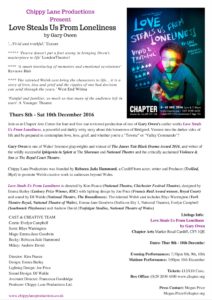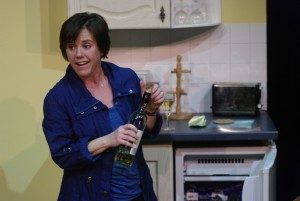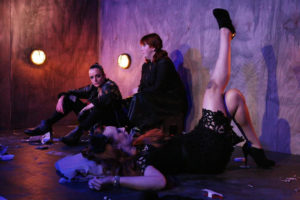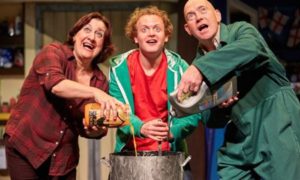
Photographic Credit Kirsten McTernan
Our project coordinator recently spoke to Rebecca Jade Hammond Artistic Director of Chippy Lane Productions
Hi Rebecca, great to meet you, your company Chippy Lane productions has the mission statement of;
“Our primary mission is to promote Welsh writing and Welsh talent to audiences beyond Wales. We aim to achieve this by producing work across both the live and recorded arts.”
I wonder if you can tell me how you work towards achieving these aims?
“We do this in a number of ways;
- By consistently keeping abreast of published Welsh playwrights work and progression.
- Encouraging new writing and work from emerging Welsh playwrights.
- Social Media/events/building communities of like minded Welsh and Welsh-loving people beyond Wales.
- Expanding our events to include rehearsed readings, socials, scratch nights, fundraising evenings as well as performances.”

Following on from those objectives then your company has recently produced a new scratch night to showcase Welsh writing called “Chippy & Scratch” at The London Welsh Centre and “An Evening of Welsh Playwrights” for The Bloomsbury Literary Festival. Phew you must be busy! It sounds like you might be interested in commissioning playwrights and creatives yourself as part of your companies development. Is this something you would like to see happen?
“Yes, and it is one of the main reasons for setting up a twice annual “Chippy & Scratch Night” to seek out new and emerging, fresh Welsh writers who want to progress and take the next steps in bringing their work to the stage. From our most recent event I am currently in talks with potential writers to try and match one of them to a project for 2018, which will be our next project and inspired by the text The Glass Menagerie by Tennessee Williams.”

Your first production to be staged in Wales is “Love Steals Us From Loneliness” by Gary Owen at Chapter Arts Centre in December. Why did you choose this particular play?
“When I set up the company I wanted to create a buzz and to begin my producing portfolio with a real bang. There was no question that I had to begin with the most important and successful playwright to come out of Wales – Gary Owen. The love for his writing is so exciting and he is making a tremendous noise on the London theatre scene with the success of Iphigenia in Splott . His writing is real, raw and has that rarity with most contemporary work to flick from comedic to tragic like the flip of a coin. Love Steals, is by far my favourite piece of his and when I read it for the first time five years ago – I always said “If I ever pluck up the courage to have my own company, I need this to be the first!”

Love Steals Us from Loneliness was first staged by NTW/Sherman Cymru in Hobo’s nightclub in Bridgend Town Centre in 2010. Do you think this play still resonates for today’s audiences?
“Absolutely. I think it’s pretty timeless to be honest. The themes will always be resonant and even though in someways it is aimed at a younger demographic it can still reach further. After all everyone has or will experience, love, loss, grief, and heart ache. Some will battle with sexuality and others will venture down the wrong path or maybe overcome the tragedies in their lives to be successful, happy and content, able to exist and move forward.”

Rebecca you also champion Equality and Diversity in the Arts across the UK. As an activist and committee member for charity Act For Change. How did you become aware of the work of Act For Change and can you give us more information on your work in this area?
“Firstly it affects/has affected me as a female in the arts where women are poorly represented across the board and also as a regional working class Welsh actor. On a wider level it has affected many of my friends and work colleagues who are BAME and working in the industry and it needs to change. The UK is not majority white and English and it hasn’t been for a very long time. AFC was set up in response to an ITV advert run in 2014 “Where Drama Lives” the advert failed to represent any BAME actors and brought together a collective of people across the arts to revolt and campaign for a wider awareness and change to progress diversity and equality across the arts in the UK. Our arts should reflect the society in which we live in – which is diverse and I for one can’t understand why this isn’t currently reflecting across the live and recorded arts. We have a wealth of talent in the UK and opportunity should be available for all who want it. My most recent work for AFC which includes helping with their events and social media was putting into action a fair casting process for Love Steals. I spent four months ploughing through Twitter, Facebook, the internet, spotlight and drama schools to find BAME actors who were authentic Welsh. I’m not going to lie it proved difficult as Wales – doesn’t seem to have many and this is a major concern.”
Are you aware of any barriers to equality and diversity for either Welsh or Wales based artists?
“I went to showcases and performances in and out of Wales to build up a portfolio of actors who were Welsh. Of the 180 that I currently have in my portfolio 35% are BAME and 25% are over the age of 35. Whilst I worked really hard to raise these figures – it isn’t good enough and it’s not from lack of research or trying. I tried to find a fair amount of actors who represented that bracket to go into the casting process, but sadly there wasn’t enough and I’m concerned that it comes from education predominantly.
We need schools to be studying / performing / spreading awareness of stories of BAME communities and we need to take young people to watch these stories being performed. For example The Mountaintop at The Other Room, Cardiff – A teenager of colour might have seen Alexandria Riley’s performance and gone away thinking “Wow – She’s amazing and she looks like me. That story was about a part of my culture, I want to be like her.” Children want to see themselves in the characters in theatre as well as television and film. Give them that, then that seed will grow from a passion to a hobby and then to a potential career giving progression and more diversity in Wales.”
If you were able to fund an area of the arts in Wales what would this be and why?
I would give the funding to primary schools and secondary schools to finance their theatre trips. We need to capture the next generation of creatives at a young age and show them worlds that can only belong on stage and captivate them. Culture them and nurture them to realise the beauty and possibilities of different types of Theatre. By giving them free tickets to the theatre they will experience a different type of education and in light of the wealth of work swelling in and out of Wales at the moment, perhaps they will see a reflection of what they could do or who they could be in those productions.”
And finally what personally excites you about the arts in Wales? Is there a production you have experienced recently that you would like to share with our readers?
“The arts in Wales are changing. It’s not the place I left in 2004, there is wealth and excitement for Theatre that is new, diverse and vibrant. The Other Room, The Sherman Theatre and NTW to name a few are taking enormous leaps producing great work and reaching new audiences and then take this work beyond Wales to engage with other parts of the UK – this is wonderful news.
As for a production I think I would choose the The Weir at The Sherman Theatre. Mostly because it was giving voice to Irish culture and Irish life and that is what I want Chippy Lane to do beyond Wales. Bring a bit of Welsh culture beyond Wales. As an Artistic Director I want to hear as many stories from all around the world as I can and the wonder of Theatre allows you to do that rather beautifully.”
Thanks for your time Rebecca



 (3 / 5)
(3 / 5)
 (5 / 5)
(5 / 5)
 (1 / 5)
(1 / 5)





 (4 / 5)
(4 / 5)








